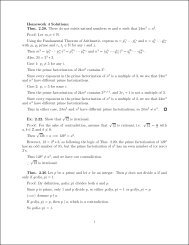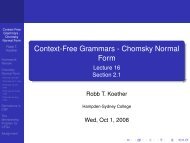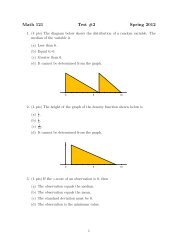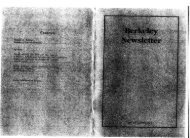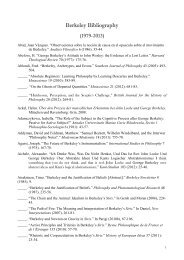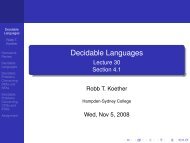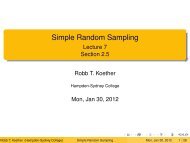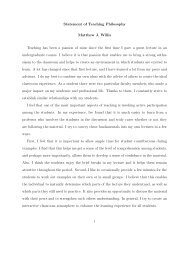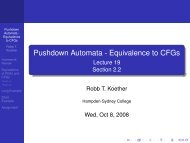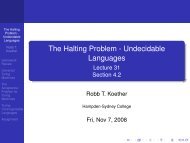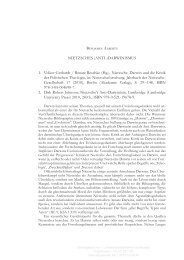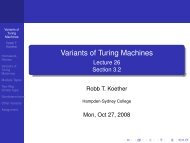Math 121 Test #1 Spring 2012
Math 121 Test #1 Spring 2012
Math 121 Test #1 Spring 2012
Create successful ePaper yourself
Turn your PDF publications into a flip-book with our unique Google optimized e-Paper software.
<strong>Math</strong> <strong>121</strong> <strong>Test</strong> <strong>#1</strong> <strong>Spring</strong> 20<strong>121</strong>. (5 pts) A graduate student is designing a research study. She is hoping to showthat the results of an experiment are statistically significant. What type ofp-value would she hope to obtain?(a) A large p-value.(b) A small p-value.(c) The magnitude of a p-value has no impact on statistical significance.2. (4 pts) A research article reports the results of a new drug test. The drug isto be used to decrease vision loss in people with macular degeneration. Thearticle gives a p-value of 0.04 in the analysis section. For each of the followinginterpretations of the p-value, indicate whether it is valid or invalid.(a) The probability of getting results as extreme as or more extreme than theones in this study if the drug is actually not effective.(b) The probability of getting results as extreme as or more extreme than theones in this study if the drug is actually effective.(c) The probability that the drug is not effective.(d) The probability that the drug is effective.3. (4 pts) A college official conducted a survey to estimate the proportion of studentscurrently living in dormitories about their preference for single rooms,double rooms, or multiple (more than two people) rooms in the dormitories oncampus. Which of the following does not affect the college official’s ability togeneralize the survey results to all dormitory students?(a) Five thousand students live in dormitories on campus. A simple randomsample of only 500 were sent the survey.(b) The survey was sent only to first-year students.(c) Of the 500 students who were sent the survey, only 160 responded.(d) All of the above present a problem for generalizing the results.4. (5 pts) In the previous problem, if the electrician rejects the null hypothesis,then he could be making(a) A Type I error.(b) A Type II error.(c) The correct decision.(d) Either (a) or (b).(e) Either (a) or (c).(f) Either (b) or (c).1
5. (5 pts) The following situation models the logic of a hypothesis test. An electricianuses an instrument to test whether an electrical circuit is defective. Theinstrument sometimes fails to detect that a circuit is good and working. Thenull hypothesis is that the circuit is good (not defective). The alternative hypothesisis that the circuit is not good (defective). If the electrician rejects thenull hypothesis, which of the following statements is true?(a) The circuit is definitely not good and needs to be repaired.(b) The electrician decides that the circuit is defective, but it could be good.(c) The circuit is definitely good and does not need to be repaired.(d) The circuit is most likely good, but it could be defective.6. (4 pts) The purpose of a pie chart is to(a) Show the shape of the distribution.(b) Facilitate the comparison of one category to another.(c) Facilitate the comparison of one category to the whole.(d) Facilitate the comparison of one sample to another.7. (18 pts) There are two bags: Bag A and Bag B. Each bag contains 20 vouchersworth various amounts from $10 to $60. The distributions in the two bags areshown in the following diagrams.$10 $20 $30 $40 $50 $60 $10 $20 $30 $40 $50 $60Bag ABag BWe are handed one of the bags, but we do not know which one it is. The twobags are identical in appearance. We will draw one voucher at random from thebag we are holding and, based on its value, we will decide which bag we believeit to be. The two hypotheses areH 0 : We are holding Bag A.H 1 : We are holding Bag B.2
(a) (3 pts) What is the direction of extreme?(b) (8 pts) Our decision rule is to reject H 0 if the value of the selected voucheris $50 or more. Find the values of α and β.(c) (4 pts) What is the p-value of 30?(d) (3 pts) Describe a Type I error in this situation.8. (15 pts) A recent study 1 , reported in The Globe and Mail 2 , concludes that doctorsare not always honest with their patients. Among the study’s conclusionsare the following.• One third of physicians did not completely agree with the need to revealserious medical errors to patients.• Nearly two fifths did not completely agree that they should disclose theirfinancial ties to drug and device companies.• Almost one fifth did not completely agree that physicians should never tella patient something untrue.• Just over one tenth said they had told patients something false in theprevious year.(a) (3 pts) The article in The Globe and Mail goes on to say “Of course, thataccounts only for doctors who told interviewers the truth.” To what typeof bias does this statement allude?(b) (3 pts) The article says that “just over one tenth said they had told patientssomething false in the previous year.” Is this figure of 10% a parameter, astatistic, a variable, or a p-value? (Choose one)(c) (3 pts) The article says that the researchers surveyed “1,891 practicingphysicians throughout the United State.” Based on this statement, describethe population of interest.(d) (3 pts) Suppose that the 1891 physicians had intentionally been chosenfrom the alumni of the Harvard Medical School. What type of bias wouldbe present?(e) (3 pts) Suppose that the researchers intentionally selected 500 physiciansfrom hospital staffs, 1000 physicians from private practice in metropolitanareas, and 391 physicians from private practice in small towns. What typeof sample would this be?1 http://content.healthaffairs.org/content/31/2/383.abstract2 http://www.theglobeandmail.com/life/the-hot-button/is-your-doctor-lying-to-youprobably-according-to-a-new-study/article2338707/3
9. (24 pts) A college administrator wishes to study the relation between sleep andacademic performance. He selects 100 college students and asks each student totell him the average number of hours of sleep the student gets per night and theadministrator also looks up the student’s GPA. He finds that of the studentswho get an average of at least 7 hours of sleep per night, their average GPA is3.2 and of those who get less than an average of 7 hours of sleep per night, theiraverage GPA is 2.9.(a) (4 pts) Describe verbally the statistics in this study.(b) (4 pts) Describe verbally the variables in this study.(c) (4 pts) Which variable(s) are explanatory and which are response?(d) (3 pts) Is this study observational or is it experimental? Explain.(e) (6 pts) Suppose that the 100 students comprised a systematic 1-in-20 sampleof the 2000 students at the college and that the administrator used hisTI-83 with a seed of 25 to select the sample. Using a seed of 25, give thelabels of the first 5 students selected to be in this study.(f) (3 pts) Which type of bias is this sampling method designed to eliminate?10. (16 pts) The following data are the final exam scores of a class of 21 students.55 55 56 64 65 69 7274 78 80 81 81 82 8384 85 87 87 87 91 92(a) (4 pts) Of the different types of graph that we studied, which ones wouldbe appropriate for these data? (List all appropriate types.)(b) (8 pts) Using one of the types that you named in part (a), draw a graphof these data.(c) (4 pts) Which of the following terms would you use to describe your distributionin part (b)?(i) Symmetric(ii) Uniform(iii) Unimodal(iv) Bimodal(v) Skewed right4



